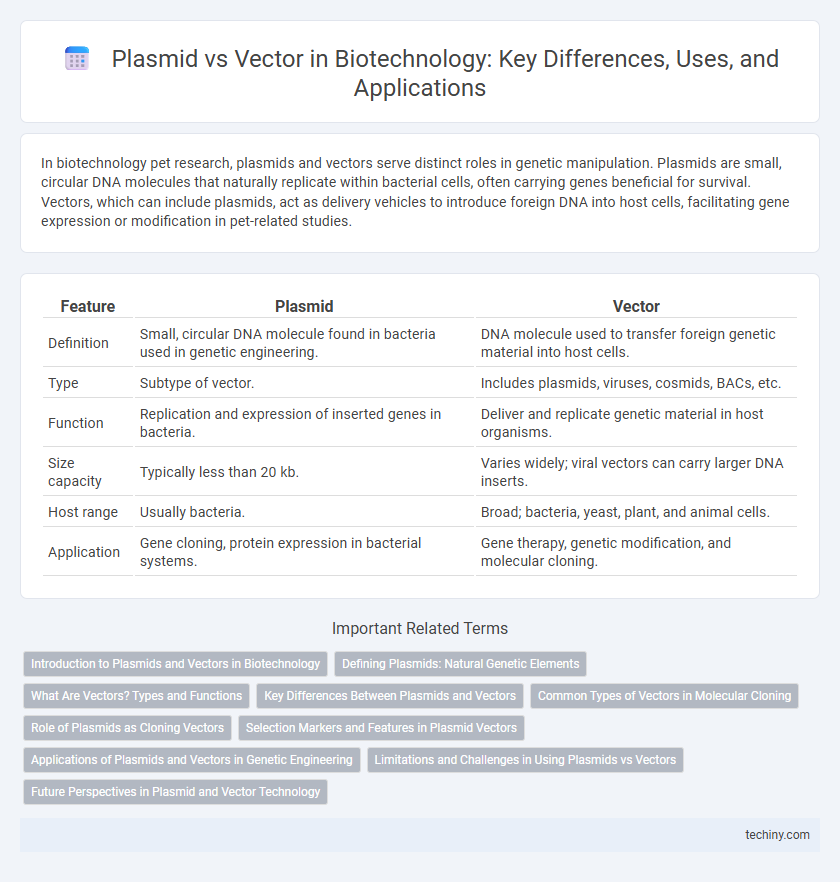In biotechnology pet research, plasmids and vectors serve distinct roles in genetic manipulation. Plasmids are small, circular DNA molecules that naturally replicate within bacterial cells, often carrying genes beneficial for survival. Vectors, which can include plasmids, act as delivery vehicles to introduce foreign DNA into host cells, facilitating gene expression or modification in pet-related studies.
Table of Comparison
| Feature | Plasmid | Vector |
|---|---|---|
| Definition | Small, circular DNA molecule found in bacteria used in genetic engineering. | DNA molecule used to transfer foreign genetic material into host cells. |
| Type | Subtype of vector. | Includes plasmids, viruses, cosmids, BACs, etc. |
| Function | Replication and expression of inserted genes in bacteria. | Deliver and replicate genetic material in host organisms. |
| Size capacity | Typically less than 20 kb. | Varies widely; viral vectors can carry larger DNA inserts. |
| Host range | Usually bacteria. | Broad; bacteria, yeast, plant, and animal cells. |
| Application | Gene cloning, protein expression in bacterial systems. | Gene therapy, genetic modification, and molecular cloning. |
Introduction to Plasmids and Vectors in Biotechnology
Plasmids, small circular DNA molecules found in bacteria, serve as essential cloning vectors in biotechnology due to their ability to replicate independently within host cells. Vectors, including plasmids, are engineered DNA carriers designed to deliver genetic material into target cells for gene expression or genetic modification. The efficiency of plasmid vectors in cloning, gene therapy, and recombinant protein production highlights their critical role in molecular biology and genetic engineering.
Defining Plasmids: Natural Genetic Elements
Plasmids are circular, double-stranded DNA molecules found naturally in bacterial cells, separate from chromosomal DNA, and capable of autonomous replication. These natural genetic elements often carry genes beneficial for bacterial survival, such as antibiotic resistance or metabolic functions, enabling horizontal gene transfer among microbial populations. Unlike synthetic vectors designed for gene cloning or therapy, plasmids serve as fundamental tools within biotechnology due to their inherent ability to replicate independently and transfer genes efficiently.
What Are Vectors? Types and Functions
Vectors are DNA molecules used in biotechnology to transfer genetic material into host cells for cloning, gene expression, or genetic modification. Common types include plasmids, bacteriophages, cosmids, and artificial chromosomes, each designed for specific functions such as gene cloning, protein production, or genomic library construction. Their primary functions involve facilitating gene insertion, replication within host cells, and expression of desired genes for research, therapeutic, or industrial applications.
Key Differences Between Plasmids and Vectors
Plasmids are naturally occurring, circular DNA molecules found in bacteria that can replicate independently, whereas vectors are engineered DNA carriers designed to deliver genetic material into host cells in genetic engineering. Unlike plasmids, which function primarily as mobile genetic elements, vectors include various types such as viral vectors and artificial chromosomes tailored for specific biotechnological applications. Key differences involve the scope of use, with plasmids serving as replicative DNA molecules in bacterial populations, while vectors act as tools for gene cloning, expression, or gene therapy.
Common Types of Vectors in Molecular Cloning
Common types of vectors in molecular cloning include plasmids, bacteriophages, cosmids, and artificial chromosomes, each serving distinct purposes based on size capacity and host compatibility. Plasmids are circular DNA molecules widely used for their ease of manipulation and ability to replicate independently in bacterial cells. Vectors like bacteriophages and cosmids allow the cloning of larger DNA fragments, while artificial chromosomes such as BACs and YACs enable cloning of very large genomic sequences for complex genetic studies.
Role of Plasmids as Cloning Vectors
Plasmids serve as essential cloning vectors in biotechnology due to their ability to replicate independently within bacterial cells, facilitating gene cloning and expression. Their small size, high copy number, and the presence of multiple restriction sites allow efficient insertion and propagation of foreign DNA sequences. These properties make plasmids invaluable tools for genetic engineering, recombinant protein production, and functional genomics studies.
Selection Markers and Features in Plasmid Vectors
Plasmid vectors contain selection markers such as antibiotic resistance genes that enable the identification and propagation of successfully transformed cells. These markers, including genes for ampicillin, kanamycin, or chloramphenicol resistance, facilitate the maintenance of plasmids within host cells under selective pressure. Plasmid vectors also feature origins of replication, multiple cloning sites, and promoters to ensure efficient replication, gene insertion, and expression in various host organisms.
Applications of Plasmids and Vectors in Genetic Engineering
Plasmids serve as essential vectors in genetic engineering, facilitating the insertion and replication of foreign genes in host cells for research, pharmaceutical production, and crop improvement. Vectors, including plasmids, viral genomes, and artificial chromosomes, enable targeted gene delivery, expression control, and genome editing in various organisms. Their diverse applications enhance gene cloning, recombinant protein production, and gene therapy development, advancing biotechnological innovation.
Limitations and Challenges in Using Plasmids vs Vectors
Plasmids often face size limitations, restricting the capacity to carry large or multiple genes, which hinders complex genetic engineering applications. Vectors, particularly viral or artificial ones, can overcome these size constraints but may introduce issues such as immunogenicity, cytotoxicity, or unstable replication in host cells. Both plasmids and vectors require careful optimization to balance gene delivery efficiency, expression stability, and biosafety for successful biotechnological outcomes.
Future Perspectives in Plasmid and Vector Technology
Innovations in plasmid and vector technology are driving advancements in gene therapy, synthetic biology, and personalized medicine by enabling more precise gene delivery and expression control. Emerging techniques such as CRISPR-based vectors and non-viral plasmids offer enhanced specificity, reduced immunogenicity, and improved safety profiles. Continued optimization of vector design and plasmid backbone stability will accelerate therapeutic applications and expand the potential of genetic engineering.
plasmid vs vector Infographic

 techiny.com
techiny.com